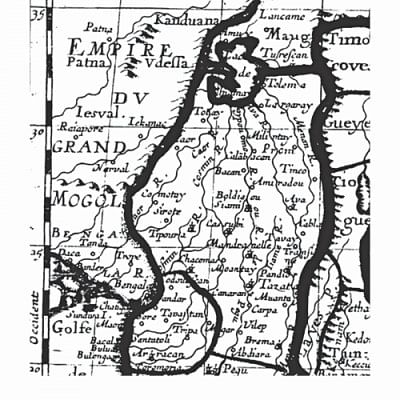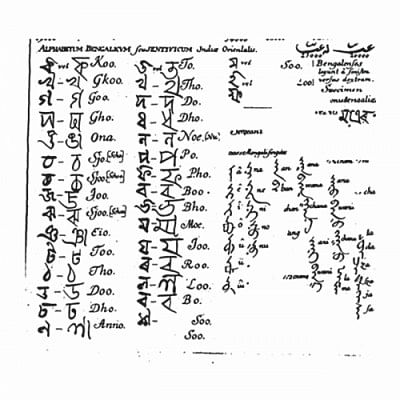The language question in 17th-century Bengal

According to received wisdom, Bangla language was just fine until the fateful emergence of Fort William College. The pundits and the Sahibs of this college on the eastern bank of Hooghly River fiercely mauled, mutilated, and marred our mother tongue beyond recognition. Word had been married to thought and the literate had been immersed in the popular until this event drew an iron curtain of alienation. Thus goes the Fort William myth, and like all myths, it contains a grain of truth: most of the folks on the payroll endorsed a stilted prose. Yet like other effortlessly reproduced wisdoms, it needs to be qualified with some ifs and buts.
In 1972, Dr Afia Dil completed her PhD from Stanford University. In her thesis, she argued that there are two communal dialects of Hindus and Muslims of Bengal. She fancies that certain loan borrowings from other languages, certain religio-communal terminology and peculiar dimorphisms like pani and jal constitute the basis for no less than two separate dialects for Hindus and Muslims. The problems with Dil's study are too many to enumerate here—including her flawed positivistic methodology, misspecification of the problem vitiated by a faulty understanding of culture and history, the thin and tenuous evidential basis riddled with basic errors, and many more. Thus goes the second myth of communal dialectology.
Probably 1952 language movement would be a key to exposing the fallacy of the two myths we have flagged above. The roots of alienation in Bangla language go back to a very different bifurcation—not between Hindus and Muslims, not between the modern and the eternal but between the high and the low, the hyperglossic languages of Arabo-Persian, Sanskrit, English, or Urdu-Hindi and the hypogloss of Bangla.
The language debate in early modern Bengal—a language movement of sorts—can add at least one angle for a proper perspective of the issue.
In early modern Bengal, the scribal elite considered the native language a base tongue that shouldn't be elevated into the realms of proper religious discourse. In the same religious "community", certain languages enjoy elevated status while vernaculars like Bangla were considered non-religious, if not downright profane. The bile was often more severe against the script than the language. Thus grew an outcrop of medieval literature written in Bangla language but Perso-Arabic script.
Yet, Bangla thrived. Despite official language of the Sultanic court being Perso-Arabic, natives widely participated in the ruling circles and the gradually acculturated court patronised Bangla works. When the patronage from Gaur dried up with the advent of Mughal era, the poets still found support from local potentates.
The case for and against writing in Bangla was made in fierce polemic. Rourava Narak was designated for those expounding Ramayana and Puranas in Bangla, where the dreadful Ruru serpent would devour the flesh of the inmates. Bengali Muslims composing religious tracts in Bangla were dubbed blasphemers and sacrilegists. If lives were not at stake, afterlives were.
The poets choosing to write in Bangla fought back, first with a whimper and then with a bang. The pioneering Bengali Muslim poets—who were Sufis—defended their choice of language. Shah Muhammad Saghir and Kazi Sheikh Mansur both argued that Bangla language was just an instrument, an exterior shell that solely has the function of conveying the religious truth. Haji Muhammad—another important Sufi poet—defended Bangla in three steps: first, he flat out denied the possibility to write about religious content in the Indic script. Then he said that he couldn't help writing a little bit finding no other resort, and finally he advised that one should not ignore the content just because it is written in the Indic script.

Do not ignore it in view of the Indic script,
Because when the summumbonum [the mystical first letter] is availed in the Bangala script
On what ground would you disregard it? (translation author's)
The venerable Saiyad Sultan developed a distinct theory—as showed by Ayesha Irani in her masterful study—of how translation itself is a critical step in the transmission of religion. He mentioned how, after Allah revealed the Quran to the prophet in the Arabs' mother tongue, the message of the religion was conveyed through translation to the Khurasanis, Javanese, Choliyas, and other peoples. This provides him with sufficient precedence to justify his translation for the sake of people of Banga. The twist is that Sultan called Bangla the Hindi language, but we should not be confused here: he merely meant that Bangla was an Indic language.
It was for Abdul Hakim, however, to give a full-throated defence of writing in Bangla, as I tried to discuss in my paper on Hakim (2016). The poet of Sandwip remains shrouded in the mist of the past, beyond the famous excerpt on Bangla language. A pushpika by a copyist is the main piece of evidence tentatively establishing Hakim's floruit in the 17th century. The famous extract Bangabani from his theological poem Noornama is found in only one manuscript copy of the work. Although Hakim is celebrated as a major voice defending Bangla language in the wilderness of "medieval" Bengal, solid research on his person and work are hard to come by.
Hakim's story is familiar: like Sultan, Mansur or H Muhammad, he was drawn to compose in Bangla to convey the messages of religion to an audience uninitiated into Arabic and Persian. He took pains to clarify that there was no aversion to Arabic or Persian. But the role of languages in theology and theophany is not transcendental, but merely instrumental. God understands all languages, and sends his scriptures in the language of the receiving people.
When it comes to writing the attributes of Allah and the prophet, there is no divergence of sense whether it is written in Arabic, Persian, or the Indic language.
The stories of God and the prophet are to be written in every literature, whether Arabic, Persian, or Indic.
Hakim explains that Arabic was the language of revelation for Arabs, for Urians Ur, for Ionia Ionian, for Syria Syriac:
Whatever languages men may speak in respective lands
The Lord understands all languages—whether it is the Indic, the language of Bengal, or any other.
Anyone may invoke the Lord in his/her own tongue. (translation author's)
Hakim goes further in this theoretical vein and mentions that “there is no hierarchy of scripts”, since the main goal is “knowing the law and guidance”. The script merely “expresses the intrinsic message”.
Together with clearing the way for his mother language, he also makes the case for making his patria, namely Bengal, just as sanctified a place as any other: “There is no hierarchy among places when it comes to obeying the commandments of God”. Putting these signposts of his metaphysical and theological doctrine, Hakim then turns the table on the Bangla-phobe, unseats them from the moral high horse and questions their legitimacy as denizens of Bengal:
Those who are not initiated into the distinctions of mystical gnosis generally denounce the scripts of the Hindu.
Those who are born in Bengal and yet denounce the language of Bengal,
I cannot ascertain the legitimacy of their birth.
Those who are not satisfied with their native language and learning,
Why don't they move to foreign lands?
We have been living in Bengal through both paternal and maternal lines for generations,
Precepts in the native language are best-suited for mental improvement. (translation author's)
This brings us back to the battle lines on language: the hostility to Bangla as a language and script of the barbarians, the outcastes, or the infidels reflects a gaze of the spiritual outsider—the ashraf, the castist, the imperialist. The politico-religious opposition against non-Muslim natives translated into opposition against the language and culture. Abdul Hakim situated himself not outside, but amid the Bengali audience, bound together in empathy. The chaste Qadiriya Sufi that he was, Hakim made no bones about picking up didactic stories from the Ramayana along with the standard stories from the Islamic and Jewish lore in his book Durr-e-Majlish. We could locate this openness in, among other things, the genre of the text: it was what in Jewish tradition would be called Aggadah or loose collection of examples and precepts, not legally binding but beneficial for this life and beyond. Hakim's love for his mother language does not postulate any opposition to the classical languages. Hostility against Arabic or Sanskrit is not part of Bengali national identity.
In an article called "Bange Muslim Sanskriti", Syed Muztaba Ali lamented that the Hindus and Muslims of Bengal, living for centuries side by side, never seriously enquired about the science and philosophy of each other. One cannot deny Ali's point, yet what was missing in the high culture was probably found in popular life: poets and ascetics mediated religious difference with shared language and life-world.
Poets like Alaol, Haji Muhammad or Abdul Hakim were—we should take care to note—prolific translators.
In their translation, they felt as much allegiance to the original text as to their native audience and culture. For all their defensiveness, they did not hesitate to adopt terminology from the extant Indic language for elucidating religious or spiritual doctrines. Mansur or Haji Muhammad would thus explain the terminology through one-to-one correspondence between the language of "Muslims" and that of "Yogis". The interpretation of projecting deities of Indic tradition into figures of the new tradition is most famous in the text called Niranjan-er Rushma. The simultaneous and non-contradictory evocation of different systems is what Irani refers, in the footsteps of earlier scholars, as "both/and" rhetoric and parallel enjoyment of multiple cultural systems. The key question is whether displacement of local deities by Islamic figures was the main drive, as Irani traces in Saiyad Sultan's work, or whether there was a process of "syncretism" understood as a cultural-political process—as one might alternatively argue.
Translations retell the original, but these are not necessarily neutral retellings. Valences can shift and perspectives can be reversed. Many authors over the centuries have retold the story of Rama all across South Asia and beyond, and the senses of the story have shifted at various levels, as Ramanujan showed. Our author Haji Muhammad—as an interpreter of Islamic mysticism—explained it in terms of One God to whom the entire world is immanent, irrespective of languages and creeds of human beings. At that level, the goal is not displacing other creeds, but recognising a universal relation with the universal.
The distinction between non-belief and belief does not pertain there,
The nominal distinction between the two merely creates confusion there,
When he discards the differences and merges into self,
He reaches the station of gnosis.
In the best of all possible worlds, if we follow this drift, we are not far from de-alienation across social divides. The theory of languages that the poets preached allowed them to defend their firm embrace of the mother language. In a fine mystical casing, this kernel vaguely contained the beginning of the end of sectarianism and probably heralded a vernacular humanism.
T Zami is a researcher on Bengal history. He can be reached at [email protected]
The pictures printed along with the article are from the author's upcoming articles on Bengal history.





Comments